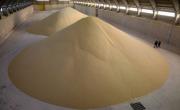Russia is a Fertilizer Superpower, Too
Fertilizer Stocks Have Soared on Putin’s War. Proceed With Caution.
By
Craig Mellow
Updated March 23, 2022 8:26 am ET
Haven’t earned enough on your oil stocks since Russia invaded Ukraine? You should have bought Nutrien , the Western Hemisphere’s top fertilizer producer, based in Saskatoon, Canada.
Its shares (ticker: NTR.Canada) have climbed 37% in the month since Vladimir Putin launched his “special military operation.” The Energy Select Sector SPDR exchange-traded fund (XLE), a proxy for Big Oil, is up a mere 13%.
As big as Russia is in oil, it’s more critical to global fertilizer markets. Farmers around the world rely on fertilizer derived from three different natural resources: potash, phosphate, and natural gas. Russia and its satellite Belarus produce more than a third of global potash, and of course dominate in natural gas. Belarus’ potash exports were strangled by Western sanctions even before the war. Russia cut its own off by executive order March 4.
Results are predictable: Potash fertilizer prices have soared by three-quarters this year. Prices for urea, one of two main “nitrogen” fertilizers distilled from gas, are up 60% in the past month.
North American producers are advantaged in this sizzling environment, through access to much less expensive natural gas than European competitors, who lean on Russian imports. A highly consolidated market adds to pricing power.
Nutrien, a vertically-integrated company that offers all kinds of fertilizers plus downstream distribution, has two major competitors on its own continent: Mosaic (MOS), which focuses on potash and phosphate, and CF Industries Holdings (CF), which works in the nitrogen/gas category.
Their shares have done as well or better than Nutrien’s. “CF can kill everyone in the market because it has cheap American natural gas,” says Charles Neivert, senior research analyst for chemicals and agriculture at Piper Sandler. The industry laggard has been Norway-based Yara International (YAR: Norway), which has to struggle with expensive European feedstocks.
How long the party—or crisis, for the rest of us who grow or eat food—lasts is another question. Peace in Ukraine looks some ways off. Even if fighting stops, restrictions will remain on Belarus, and individual sanctions on the oligarchs who control Russia’s major producers, says Joel Jackson, a senior analyst at BMO Capital Markets. “Potash will still be stressed,” he assesses.
Non-Russian fertilizer supply is elastic to a degree. Nutrien may have five or six tons spare potash capacity, more than a third of what’s offline from Russia and Belarus, reckons Brian Madden, chief investment officer at First Avenue Investment Counsel in Toronto. “Nutrien could play the Saudi Arabia of potash,” he says. The Saudi Kingdom itself, and its Gulf neighbors, are using their abundant gas stocks to increase nitrogen fertilizer output by 7%-9% a year.
Demand elasticity is more important. Farmers need to lay down fresh nitrogen/natural gas fertilizer every planting season. But they can skip a year or two with potash or phosphate by “mining the soil” for leftovers from last season. Crop shifts by growers could drive this process: Corn requires nitrogen fertilizer, wheat and soybeans use phosphate and potash. “This is a constantly dynamic environment,” says Samuel Taylor, farm inputs analyst at Rabobank. “Farmers can cut back on certain products.”
None of that will prevent fertilizer stocks from rising further, Piper Sandler’s Neivert predicts. “The cash flows of these companies are astonishing, and there’s not a lot of new capital spending that they need,” he says. Nutrien is approaching his price target of $110 a share. Mosaic and CF can climb another 20%, he thinks.
Buy-side manager Madden is more cautious. “You’re getting into the seventh or eighth inning of the current investment cycle,” he says. “Current prices are sowing the seeds of demand destruction later this year.”
He recalls the last fertilizer supercycle, which peaked in 2009. Potash prices nearly tripled in 15 months, then crashed by half over the next year. Shares in PotashCorp, one of Nutrien’s predecessor companies, lost 80% of their value.
What’s beyond argument is that frozen fertilizer exports, and direct grain shipments from both Russia and Ukraine, will be one more onerous cost of war. Wheat prices have jumped by a quarter since Putin’s invasion, corn by 18%. Nations far from the conflict will pay the heaviest price: like Egypt, which imports nearly all its food, and the rest of Africa, which relies on Russia for up to 70% of its fertilizer supplies, Rabobank’s Taylor estimates.
Agricultural prices were already rising thanks to hikes in fuel and shipping, and droughts across the key growing centers of Brazil and Argentina. “I can’t think of another time when so many inflationary factors were hitting at once,” says Jonathan Haines, senior analyst at consultant Gro Intelligence.
Ripples from the battle for Ukraine keep widening.


